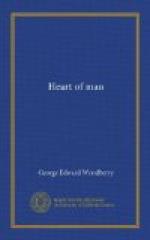“Be thou me, impetuous one!”
and thence the poem swiftly falls to its end in a lyric burst of personality, in which, while the body of nature is retained, there is only a spiritual meaning. So Burns in some songs, and Keats in some odes, following the same method, make nature their own syllables, as of some cosmic language. This is the highest reach of the artist’s power of conveying through the concrete image the soul in its pure emotional life; and in such poetry one feels that the whole material world seems lent to man to expand his nature and escape from the solitude in which he is born to that divine union to which he is destined. The evolution of this one moment of passion is lyric form, whose unity lies in personality exclusively, however it may seem to involve the external world which is its imagery,—its body lifted from the dust, woven of light and air, but alive only while the spirit abides there. And here, too, as elsewhere, to whatever height the poet may rise, it must be one to which man can follow, to which, indeed, the poet lifts men. Nor is it only nature which thus suffers spiritualization through the stress of imagination interpreting life in definite and sensible forms of beauty, but the imagery of action also may be similarly taken possession of, though this is rare in merely lyrical expression.
The ideal world, then, to present in full summary these views, is thus built up, through personality in all its richness, by a perfected imitation of life itself, and is set forth in universal unities of relation, causal or formal, to the intellect in its inward, to the sense of beauty in its outward, aspects; and thereby delighting the desire of the mind for lucid and lovely order, it generates joy, and thence is born the will to conform one’s self to this order. If, then, this order be conceived as known in its principles and in operation in living souls, as existing in its completeness on the simplest scale in an entire series of illustrative instances but without multiplicity,—if it be conceived, that is, as the model of a world,—that would be to know it as it exists to the mind of God; that would be to contemplate the world of ideas as Plato conceived it seen by the soul before birth. That is the beatific vision. If it be conceived in its mortal movement as a developing world on earth, that would be to know “the plot of God,” as Poe called the universe. Art endeavours to bring that vision, that plot, however fragmentary, upon earth. It is a world of order clothing itself in beauty, with a charm to the soul, such is our nature,—operative upon the will to live. It is preeminently a vision of beauty. It is true that this beauty which thus wins and moves us seems something added by the mind in its great creations rather than anything actual in life; for it is, in fact, heightened and refined from the best that man has seen in himself, and it partakes more of hope than of memory. Here is




